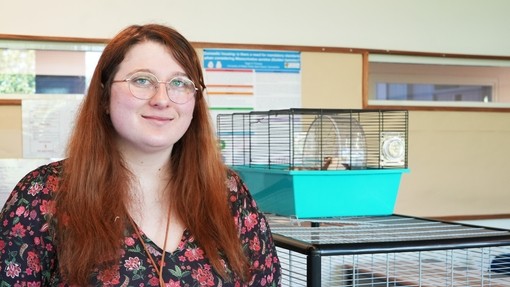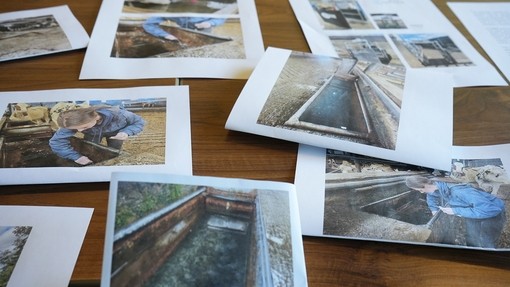Degree students showcase their animal welfare research projects
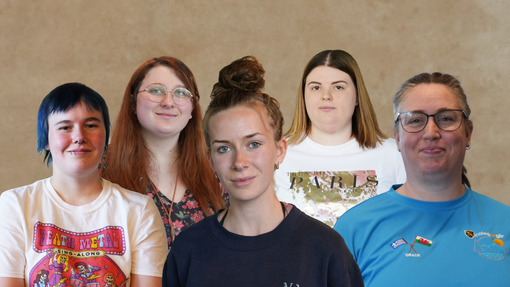
Every year, animal behaviour and welfare degree students delve into the heart of real-life challenges within the industry, through their individual research projects.
The individual research project, focused on animal welfare issues is a pivotal component of the course which is taught at the end of the degree.
Students are asked to look into specific topics relating to an area of personal interest and write a dissertation based on their research and analysis and create a poster outlining their findings.
Staff and students on campus are encouraged to visit the displays and chat to students about their findings.
This year’s research varied from tourists and loggerhead turtles in Kefalonia to biofilm on dairy farms and the impact of social media on zoo animals.
Dr Stephanie Rees, lecturer for the degree course, said: “The individual research project helps students develop advanced analytical and research skills into an area that they feel passionate about.
“It allows for both practical and academic input and it’s always great to see what students come up with every year.
“We’re looking forward to seeing this group of students along with others, graduate with their honours degrees this July.”
Find out more about the BSc Honours Animal Behaviour and Welfare degree course.
-
Following a Taith-funded college trip to Kefalonia last year to study loggerhead turtles, Grace noticed how many tourists encourage the turtles into the harbour by feeding them fish.
Fish isn’t the best food for turtles as their main diet is molluscs and crustaceans and whilst fish is a value food for loggerheads, excessive feeding can cause turtles to become overweight causing potential liver, cardiovascular disease and vitamin deficiencies.
Whilst being lured into the harbour to feed on fish, the turtles are also at risk of getting injured by harbour traffic or getting caught in fishing gear.
Grace conducted research to find out how many tourists were aware of these risks and the nutritional needs of turtles and used online platforms to find out, using sites such as ‘I Love Kefalonia’.
She also identified a lack of signage at Argostoli harbour, where the college visit took place last year, to deter the feeding of turtles.
Whilst in Kefalonia, Grace took part in harbour and snorkelling surveys and looked for turtle tracks to establish nest locations. “It was an experience of a lifetime,” she said. “I experienced things I’d never thought I’d ever do. I learnt so much from the talks and experiences we were given.
“I’d been out of education a while before starting this degree and although I’ve been through some personal challenges along the way, I have loved it and I am proud of myself.”
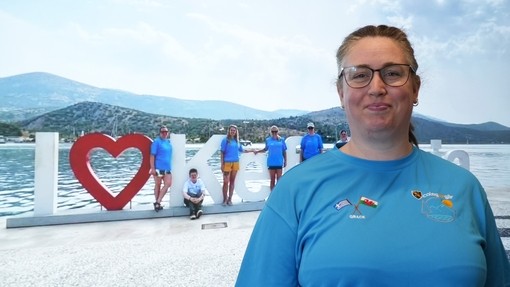
-
Biofilm is a sticky, grimy film that holds bacteria within water where often our water systems pass through it.
In livestock housing, biofilm commonly colonise water troughs, bedding and feeding areas, creating reservoirs for e-coli, streptococcus and pseudomonas.
Amy undertook some testing at four different farms willing to take part in her research using environmental sampling using swabs, blood and chromogenic agars to identify pathogenic species.
Organisms such as these can be detrimental to farming practices as they can lead to mastitis, elevated somatic cell counts and long-term productivity loss.
With the help of Pruex, a company that specialises in a probiotic approach, farms received targeted biofilm control regimes including enzymatic surface treatments and probiotic competitive exclusion agents.
The testing was carried out from September 2024 and March 2025 and interventions were applied consistently over a six-month period.
Amy Bowskill said: “Often, the natural response to biofilm is to treat it with chlorine, but that also removes the good bacteria.
“In the study, you could see where algae was building up above a herd’s water supply because the cows were drinking, then flicking the water out of their mouths.
“We took swabs before treatment and treated the areas with probiotics and the results following the treatment were significantly better.”
Initial testing showed that a trough on one farm tested positive for e-coli, streptococcus, bacillus and other dangerous organisms but by March, this was 98:2 in favour of a clearer result.
Amy was also presented with five cows with chronic mastitis and following the treatment, four of them showed significant signs of improvement.
Not having adequate and clean water affects the health of animals which ultimately can lead to dehydration and affects the farm’s milk yield.
Although Amy has experience in sheep farming, this is her first insight into dairy farms and not having any knowledge about biofilm a year ago, the test results sparked a passion.
Amy Bowskill added: “I’ve gained a lot of confidence from this course; it provides so much for everyone.
“It’s so open with so many different topics such as biology, welfare and nutrition and I would never have experienced working with microbiology without doing this project.”
![A range of photos displaying the harmful build up in farm feeding equipment]()
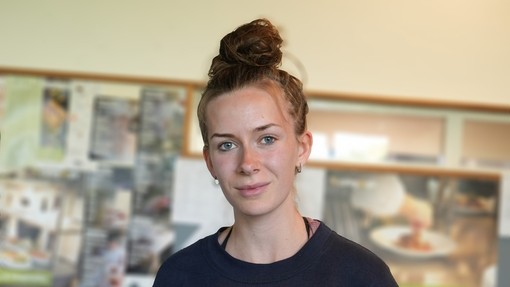
-
Clare Bentley works within a canine daycare centre where she conducted research into its services.
Working at Dog House Day Care and Grooming in Llansamlet, Clare noticed the canine equivalent of the ‘school run’, with people dropping off their dogs before work and collecting them on their way home.
She was interested in the perceptions of people who use the service which includes daycare, boarding and grooming.
With a passion for animals, Clare is studying a degree following completion of level two and three qualifications in animal care and animal management.
The research provided meaningful insights into dog owners motivations and satisfaction with the service, revealing a shift from practical concerns like location and scheduling to a deeper focus on care quality and emotional trust in the service.
The data also gave an indication on how staff provided attentiveness to specific needs like coat type and allergies, reinforcing the importance of personalised care in line with industry expectations for tailored services that balance grooming with individual welfare.
Clare Bentley commented on her time studying the degree, she said: “There’s always something new to learn as there are so many species to study, from insects to marine mammals, so if you’re looking to go into ecology or zoological work, it’s nice to have the option of studying a wide range of animals.”
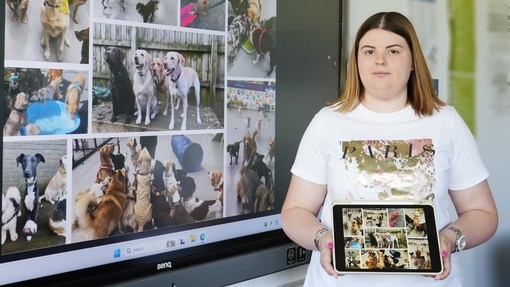
-
Simon looked at the impact of social media on animals based in zoos, specifically in Thailand and Scotland.
Trying to determine whether social media has a positive or negative impact, Simon focussed on two pygmy hippos that were receiving social media coverage in zoos.
Moo Ding, born in Khao Kheow open zoo in Thailand, was an internet sensation after her keeper posted daily updates on her which mounted to thousands of posts online.
Haggis, in comparison at Edinburgh Zoo, was kept out of the public eye for 30 days for essential bonding time with her mother.
Moo Ding’s online popularity drew visitors to the zoo but it also caused negative behaviour and expectations, with some visitors throwing water or seashells at her when they found her sleeping during their visit.
Simon Burton said: “I think zoos should post more educational content and explain why they are doing what they are doing.
“Pygmy hypos are endangered in the wild so conservation is key to their continuation.”
Simon is currently working in a retirement yard for horses and has a keen interest in conservation.
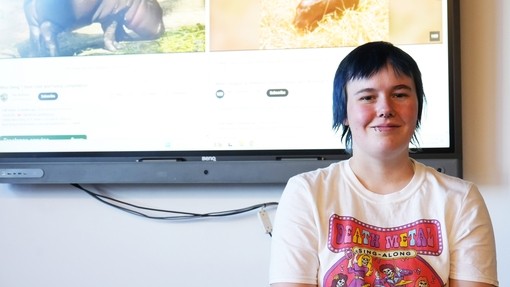
-
Tegan has been rescuing hamsters for the past five years and sees a common theme in the return of pets due to bar biting or even biting humans.
These signs are commonly seen under a stressful environment, often when cage sizes are not big enough to ensure a natural and happy environment for a hamster.
She chose this topic following ethical considerations raised in 2024 by the UK public, resulting in a petition to ban inadequate-size cages which wasn’t taken any further by DEFRA despite more than 11,000 signatures.
Tegan’s research explores whether cage size has a behavioural impact on the wellbeing of the species and to determine if there is a need to introduce mandatory cage size standards for the breed.
Tegan Thomas said: “Their cage is their whole world.
“They should be able to display natural behaviours such as burrowing, they might be small but they should have enough room to exercise and play to encourage their natural behaviour.”
She really wants to help the cause and is planning to publish her findings and look into working in conservation or data analysis as well as supporting other animal welfare related projects.
Tegan added: “There are so many concerns and issues relating to people giving away their animals and others pretending to adopt them but using them as live feed instead.
“On the course, we learn in-depth about welfare and ethics and it’s actually helped me see how other people perceive animals outside of my own personal feelings and how conservation can help animals and what we can do as a society to help and how we should look after our planet.”
Having previously worked at Pets at Home, Tegan has had an insight into the pet industry which has been useful in her course.
